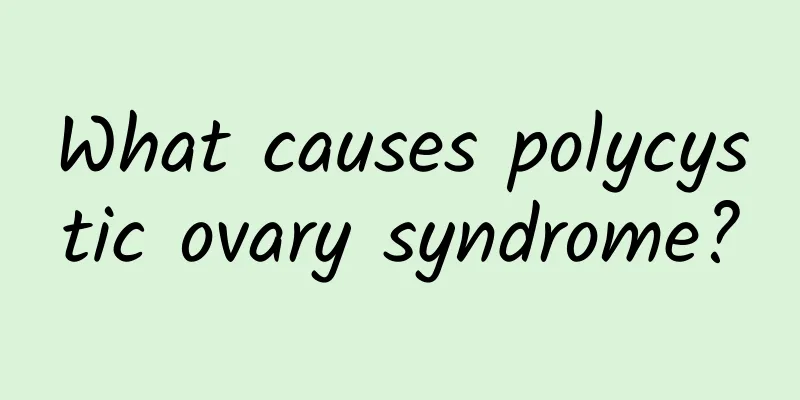What causes polycystic ovary syndrome?

|
Polycystic ovary is a relatively common female endocrine disease and is also relatively common in today's society. When this happens, it often leads to masculinization of women, such as thick body hair, menstrual disorders, and amenorrhea. There are many causes of polycystic ovary, such as abnormal ovarian axis regulation, adrenal dysfunction, etc. Let’s take a look at this aspect. What causes polycystic ovary syndrome? In fact, the etiology and pathology of PCOS are not yet fully understood. It is generally believed to be related to abnormal regulation of the hypothalamus-pituitary-ovarian axis, hyperinsulinemia and insulin resistance, adrenal endocrine abnormalities and genetic factors. Its endocrine characteristics are excessive secretion of androgens and luteinizing hormones and abnormal secretion of estrogen. What are the causes of polycystic ovary syndrome in women? Here is a detailed introduction for you: 1. Abnormal regulation of the hypothalamus-pituitary-ovarian axis: Because mental stress, drugs and certain diseases affect the endocrine function of the hypothalamus-pituitary gland, the pituitary gland's sensitivity to Gn-RH increases, resulting in excessive secretion of LH and dysfunction of cytochrome, which serves as an androgen-forming enzyme in the ovaries, leading to excessive production of androgens by ovarian interstitial and theca cells. 2. Insulin resistance and hyperinsulinemia: Some PCOS patients, especially obese patients, may show hyperinsulinemia and insulin resistance, suggesting that it is caused by insulin resistance. There are many causes of insulin resistance. In most cases, it is caused by disorders in the information conduction system after the insulin receptor. There may also be insulin receptor defects. Hyperinsulinemia can inhibit the synthesis of sex hormone binding globulin (SHBG) in the liver and increase free androgens in the body. Androgens can also increase LH secretion through the pituitary insulin receptors. Patients with severe insulin resistance may develop a syndrome of androgen excess, insulin resistance, and acanthosis nigricans, which is characterized by a state of high ketones and high insulin. Acanthosis nigricans is a hallmark of insulin resistance. 3. Abnormal adrenal function: 10% of PCOS patients have elevated levels of dehydroepiandrosterone (DHEA) and dehydroepiandrosterone sulfate (DHEAS), which are related to increased activity of key enzymes in the adrenal glands that synthesize prostate hormones, as well as increased sensitivity and hyperfunction of adrenal cells to adrenocorticotropic hormone (ACTH). Hyperfunction of the adrenal cortex and excessive secretion of androgens can cause anovulation and symptoms similar to polycystic ovary. 4. Genetic factors: The high degree of familial clustering of PCOS suggests that a major factor in its etiology may be genetic factors. Although there is evidence suggesting that candidate genes associated with the onset of PCOS are located in the insulin receptor gene, the cytochrome gene encoding cholesterol side-chain cleavage enzyme, the sex hormone binding protein gene, etc., no specific PCOS gene has been found, and PCOS may be related to multiple gene abnormalities. A small number of cases of PCOS have chromosomal abnormalities. |
>>: What to do with left soft nest cyst
Recommend
TCM liver care: Six lifestyle habits to help you protect your liver
The liver is the largest metabolic organ in the h...
What does endocervical effusion mean?
Cervical effusion is a common cervical disease. B...
How to quickly reduce inflammation of gallstones
Gallstones are the direct cause of cholecystitis....
Is Hepatitis C Type 3 a difficult type to treat?
Hepatitis C mainly refers to the infection of the...
Precautions after rabies vaccination
Now our living standards are constantly improving...
Steamed Taihu Whitefish
Taihu whitefish is a well-known fish variety. It ...
What are the effects, functions and methods of consumption of Tianjihuang?
Tianjihuang is actually a traditional Chinese med...
The difference between black moles and moles
Some people call the small black bumps on the ski...
Recommendations on kidney-tonifying foods, which ones do you know?
Nourishing the kidneys is an important part of da...
A complete guide to yam soup recipes. Which ones do you know?
The saponins, glycoproteins, tannins, arrestins, ...
How to quickly reduce swelling of thrombosed hemorrhoids
Don't be too anxious if you have thrombosed h...
Solve tinnitus, these actions are the most practical
Tinnitus is one of the most common diseases in li...
How many days does acute pulpitis usually hurt?
Toothache is a common phenomenon in our daily lif...
What to do if your child has a fever and red spots all over his body
When a child has a fever, it is easy for red spot...
Symptoms of overactive immune system
The symptoms of over-immunity are mainly abundant...









